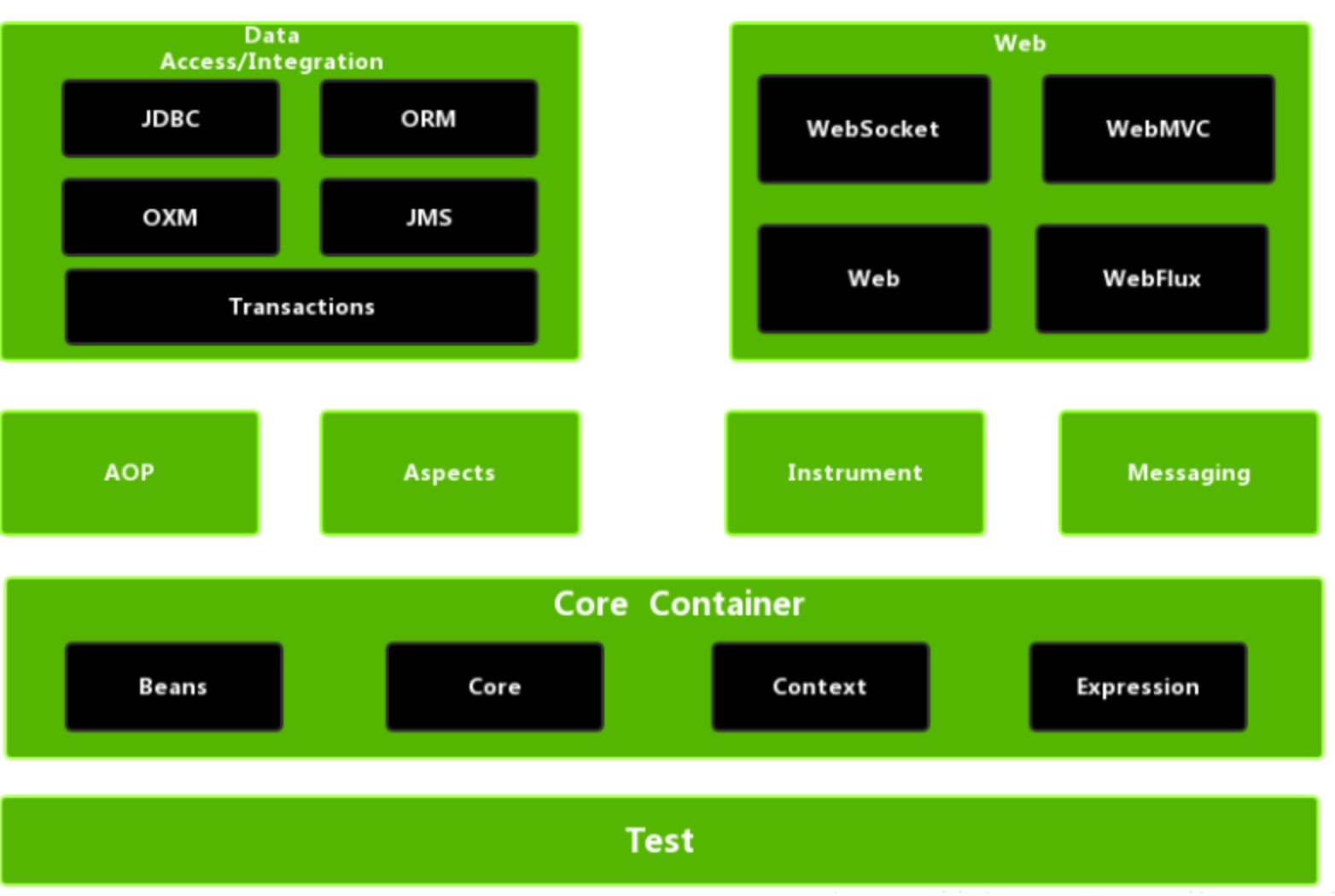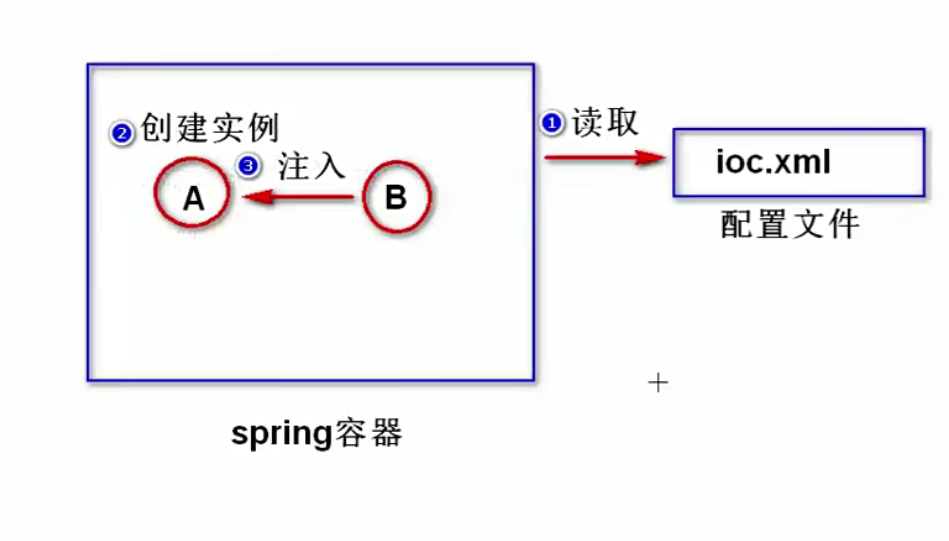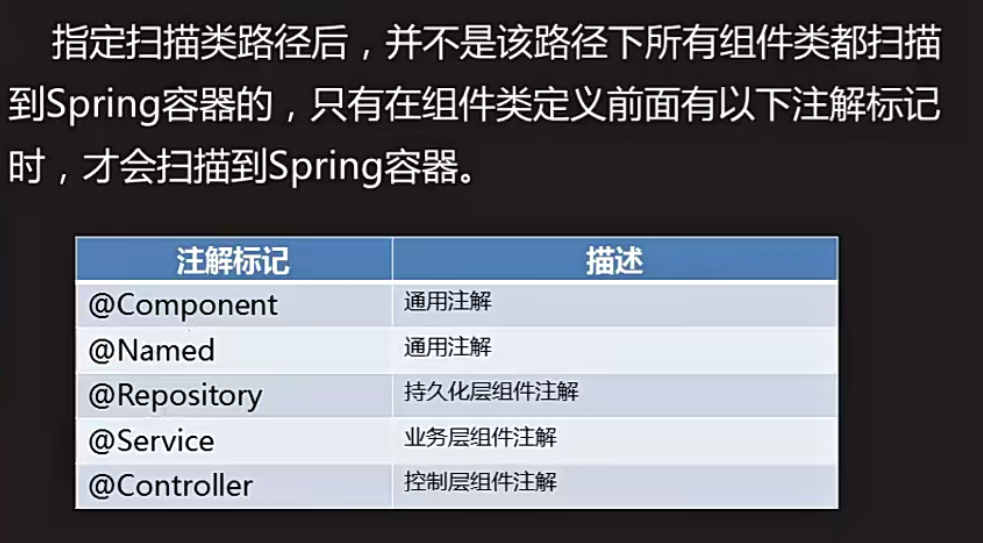给软件行业带来了春天——揭秘Spring究竟是何方神圣(一)
系列文章目录
给软件行业带来了春天——揭秘Spring究竟是何方神圣(一)
给软件行业带来了春天——揭秘Spring究竟是何方神圣(二)
给软件行业带来了春天——揭秘Spring究竟是何方神圣(三)
给软件行业带来了春天——揭秘Spring究竟是何方神圣(四)
给软件行业带来了春天——揭秘Spring究竟是何方神圣(五)
文章目录

简介
Spring是一个JavaEE开源的轻量级别的框架,可以解决我们企业开发中遇到的难题,能够让编码变的更加简单,核心组件IOC容器和Aop面向切面编程。
spring优点:
- 方便解耦,简化开发
- 管理对象
- 集成其他框架
- Junit单元测试
- 方便进行事务操作
- 降低API开发难度
spring框架图
Spring 是模块化的。
Core 容器
Core 容器由 Core、Beans、Context 和 Expression Language 模块组成。
- Core 模块提供了框架的基本部分,包括 IoC 和依赖注入功能。
- Bean 模块提供了 BeanFactory,它是工厂模式的一个复杂的实现。
- Context 模块建立在 Core 和 Beans 模块提供的坚实基础之上,它是访问任何已定义和配置的对象的媒介。 ApplicationContext 接口是上下文模块的焦点。
- SpEL 模块提供了一种强大的表达式语言,用于在运行时查询和操作对象图。
数据访问/集成
数据访问/集成层由 JDBC、ORM、OXM、JMS 和 Transaction 事务模块组成。
- JDBC 模块提供了一个 JDBC 抽象层,它消除了繁琐的 JDBC 相关编码的需要。
- ORM 模块为流行的对象关系映射 API 提供集成层,包括 JPA、JDO、Hibernate 和 iBatis。
- OXM 模块提供了一个抽象层,它支持 JAXB、Castor、XMLBeans、JiBX 和 XStream 的 Object/XML 映射实现。
- Java 消息传递服务 JMS 模块包含用于生成和使用消息的功能。
- Transaction 模块支持对实现特殊接口的类和所有 POJO 的编程和声明式事务管理。
Web
Web 层由 Web、Web-MVC、Web-Socket 和 Web-Portlet 模块组成。
- Web 模块提供了基本的面向 Web 的集成功能,例如多部分文件上传功能以及使用 servlet 侦听器和面向 Web 的应用程序上下文初始化 IoC 容器。
- Web-MVC 模块包含 Spring 的 Web 应用程序的 Model-View-Controller(模型-视图-控制器) (MVC) 实现。
- Web-Socket 模块支持 Web 应用程序中客户端和服务器之间基于 WebSocket 的双向通信。
- Web-Portlet 模块提供了在portlet 环境中使用的MVC 实现,并反映了Web-Servlet 模块的功能。
其他
如 AOP、Aspects、Instrumentation、Web 和 Test 模块。
- AOP 模块提供了一个面向方面的编程实现,允许您定义方法拦截器和切入点,以清晰地解耦实现应该分离的功能的代码。
- Aspects 模块提供与 AspectJ 的集成,AspectJ 又是一个强大且成熟的 AOP 框架。
- Instrumentation 模块提供类检测支持和类加载器实现以用于某些应用程序服务器。
- Messaging 模块支持将 STOMP 作为 WebSocket 子协议在应用程序中使用。 它还支持注解编程模型,用于路由和处理来自 WebSocket 客户端的 STOMP 消息。
- Test 模块支持使用 JUnit 或 TestNG 框架对 Spring 组件进行测试。
Spring核心特性:

依赖注入 (DI):
Inversion of Control (IoC) 控制反转是一个通用概念,可以用多种不同的方式表达。 依赖注入只是控制反转的一个具体例子。在编写复杂的 Java 应用程序时,应用程序类应尽可能独立于其他 Java 类,以增加重用这些类的可能性,并在单元测试时独立于其他类对其进行测试。 依赖注入有助于将这些类粘合在一起,同时保持它们的独立性。
依赖注入简单来说,例如,依赖,A 类依赖于B类。注入就意味着,B 类将被 IoC 注入到 A 类中。
面向切面编程(AOP)
跨越应用程序多个点的功能称为横切关注点,这些横切关注点在概念上与应用程序的业务逻辑分开。 有各种常见的好例子,包括日志记录、声明式事务、安全性、缓存等。
OOP 中模块化的关键单元是类,而 AOP 中模块化的单元是方面。 DI 可帮助您将应用程序对象彼此分离,而 AOP 可帮助您将横切关注点与它们影响的对象分离。
面向切面是一种思想,不是具体的框架,也不是具体的代码。
更多消息可以去官方文档查看。
spring的官网:Home
Spring官方下载依赖jar包地址:JFrog
spring教程:Spring 教程
Spring核心知识点
SpringIOC
IOC(Inversion of Control) 控制反转是一种面对对象编程的设计原则,用于降低代码之间的耦合度。IOC容器主要作用就是创建对象和处理对象之间的依赖关系。
Bean的管理
- 使用spring创建对象
- 使用spring注入属性
创建对象
- 单独new方式—耦合度太高
每次单独new对象,没有实现统一管理对象,如果后期userDao的名称信息发生变化的情况下,需要改变的引用地方比较多,耦合度太高。
- 工厂模式—降低我们耦合度
概念:统一的管理和维护我们每个对象创建与使用的过程。
不需要自己new对象。
- 反射的方式
降低代码的-耦合度
反射创建对象
方法一:调用无参数构造器创建对象
- 利用无参构造器
- 给类添加一个无参构造器(缺省构造器)
- 配置bean元素
- 调用容器的getbean
public class Fast {
public Fast() {
System.out.println("spring创建对象方式一:通过无参构造方法");
}
}
<!--
使用无参构造器创建对象
id属性:bean的名称,要求唯一
class属性:类的全名
-->
<bean id="Fast" class="Fast"></bean>
@Test
public void test01(){
ApplicationContext applicationContext=
new ClassPathXmlApplicationContext("bean.xml");
}
输出:
方法二:调用有参构造方法来创建对象
public class Slow {
private Integer id;
private String name;
public Slow(Integer id,String name){
//super();
this.id = id;
this.name = name;
System.out.println("spring创建对象方式2:通过有参构造方法"+"\n"+id+"-"+name);
}
}
<bean id="slow" class="Slow">
<!--
constructor-arg:是有参构造方法的使用标签
index:参数的索引,从 0 开始
name: 参数名
type:参数类型(区分开关键字和封装类 int 和 Integer)
此时的创建对象相当于:SomeBean2 bean=new SomeBean2(1,"alice");
-->
<constructor-arg index="0" name="id" type="java.lang.Integer" value="1"/>
<constructor-arg index="1" name="name" type="java.lang.String" value="alice"/>
</bean>
@Test
public void test01(){
ApplicationContext applicationContext=
new ClassPathXmlApplicationContext("bean.xml");
}
输出:
方法三:使用静态工厂方法创建对象
通过调用类的静态工厂方法来创建对象
public class Fast {
public Fast() {
System.out.println("spring创建对象第3种方式:通过静态方法工厂创建");
}
}
public class FastFactory {
public static Fast getInstance(){
System.out.println("通过静态方法工厂创建对象");
return new Fast();
//相当于Fast.getInstance();
}
}
<!--
使用静态工厂方法创建对象
factory-method属性:指定一个静态方法,spring容器会调用这个静态方法来创建对象
-->
<bean id="FastFactory"
class="FastFactory"
factory-method="getInstance"></bean>
@Test
public void test01(){
ApplicationContext applicationContext=
new ClassPathXmlApplicationContext("bean.xml");
}
输出:
方法四:使用实例工厂方法来创建对象
调用对象的实例方法来创建对象
public class cost {
public cost(){
System.out.println("通过实例工厂创建对象");
}
}
public class costFactory {
public cost getInstance(){
return new cost();
}
}
<!--通过实例工厂创建对象
使用实例工厂方法来创建对象
factory-bean属性:指定一个bean的ID,
factory-method属性:指定一个方法
spring容器会调用这个bean的对应的方法来创建对象。
costFactory factory=new costFactory();
cost cost=factory.getInstance();-->
<bean id="factory" class="costFactory"></bean>
<bean id="cost" factory-bean="factory" factory-method="getInstance"></bean>
@Test
public void test01(){
ApplicationContext applicationContext=
new ClassPathXmlApplicationContext("bean.xml");
}
输出:
方法五:使用实例工厂创建对象
public class messageBean {
public messageBean(){
System.out.println("通过实现FactoryBean接口实现对象的创建");
}
}
public class bean implements FactoryBean<messageBean> {
@Override
public messageBean getObject() throws Exception {
return null;
}
@Override
public Class<?> getObjectType() {
return null;
}
@Override
public boolean isSingleton() {
return true;
}
}
<!--通过factorybean 来创建对象-->
<bean id="factotybean" class="bean"></bean>
@Test
public void test01(){
ApplicationContext applicationContext=
new ClassPathXmlApplicationContext("applicationContext.xml");
messageBean bean=applicationContext.getBean("factotybean", messageBean.class);
}
输出:
DI依赖注入
spring容器通过调用对象提供的set方法或者构造器来建立依赖关系。
依赖关系的创建流程
spring 容器启动后读取配置文件


基于对象属性set方法进行注入
在Bean标签下 在定义一个属性<property>标签
- property元素:表示使用set方法来注入依赖关系
属性值包含特殊符号
1 把<>进行转义 < >
2 把带特殊符号内容写到CDATA
<!--<property name="bookName" value="<<武汉>>"></property> -->
<property name="bookName">
<value><![CDATA[<<武汉>>]]></value>
</property>
- name属性:指定属性值
- ref属性:指定属性值(是被注入的bean的ID)
<!--
property元素:表示使用set方法来注入依赖关系
name属性:指定属性值
ref属性:指定属性值(是被注入的bean的ID)
<!--null值-->
<property name="address"><null/></property>
<!--属性值包含特殊符号
1 把<>进行转义 < >
2 把带特殊符号内容写到CDATA -->
<property name="address"><value><![CDATA[<<上海>>]]></value>
</property>
-->
//注入属性 外部bean
<bean id="dc1" class="ioc.dc">
<bean id="db1" class="ioc.db">
<property name="di" ref="dc1"></property>
</bean>
public class db {
private IB di;
private String name;
public void setName(String name) {
this.name = name;
}
public void setDi(IB di) {
this.di = di;
System.out.println("调用了方法");
}
}
public class di implements IB{
private String diname;
public di(){
}
public void setDiname(String diname) {
this.diname = diname;
}
public void f1(){
System.out.println("注入bean的属性");
}
}
/*test01
测试set方式的注入
* */
@Test
public void test01(){
db db=abstractApplicationContext.getBean("db1",ioc.db.class);
logger.info("依赖注入成功。");
}
输出: 
注入属性—外部bean
//注入属性 外部bean
<bean id="dc1" class="ioc.dc">
<bean id="db1" class="ioc.db">
<property name="di" ref="dc1"></property>
</bean>
注入属性—内部bean
//注入属性---内部bean
<property name="name" value="mysql"></property>
<property name="di" >
<bean id="di2" class="ioc.di">
<property name="diname" value="MYSQL AB"></property>
</bean>
</property>
</bean>
利用构造器方式进行注入
在Bean标签下 在定义一个属性**标签**
constructor-arg 元素:构造器方式注入
name 指定参数列表名称_,_** **index 指定参数列表索引,参数的下标(从0 开始)
public class A {
private B b;
public A(){
System.out.println("A");
}
public A(B b){
System.out.println("构造器方式注入");
this.b=b;
}
public void execute(){
System.out.println("成功注入");
b.f1();
}
}
public class B {
public B(){
System.out.println("对象被创建");
}
public void execute(){
System.out.println("execute");
}
public void f1(){
System.out.println("被成功注入");
}
}
<!--
constructor-arg 元素:构造器方式注入,其中,index 属性指定参数的下标(从0 开始)
-->
<bean id="b1" class="DI.B"></bean>
<bean id="a1" class="DI.A">
<constructor-arg index="0" ref="b1"></constructor-arg>
</bean>
/*
* 构造器注入
* */
@Test
public void test01(){
A a1=applicationContext.getBean("a1",A.class);
a1.execute();
logger.info("构造器方式注入完成");
}
输出:
p名称空间注入
Xml头部引入P标签:
<?xml version="1.0" encoding="UTF-8"?>
<beans xmlns="http://www.springframework.org/schema/beans"
xmlns:xsi="http://www.w3.org/2001/XMLSchema-instance"
xmlns:p="http://www.springframework.org/schema/p"
xsi:schemaLocation="http://www.springframework.org/schema/beans
http://www.springframework.org/schema/beans/spring-beans.xsd">
</bean>
使用p标签注入属性:
<bean id="Book" class="book" p:bookName="books" p:bookPrice="66">
</bean>
p名称注入也是调用了set 方法注入属性。
集合类型属性注入
- 注入数组类型
2. 注入list集合类型
3. 注入Map集合类型属性
4. 注入set集合属性
public class stu {
//四种类型属性
private String[] courses;
private List<String> list;
private Map<String,String> map;
private Set<String> set;
//学生所学多门课程
private List<course> courseList;
public void setCourseList(List<course> courseList) {
this.courseList = courseList;
}
public String[] getCourses() {
return courses;
}
public void setCourses(String[] courses) {
this.courses = courses;
}
public List<String> getList() {
return list;
}
public void setList(List<String> list) {
this.list = list;
}
public Map<String, String> getMap() {
return map;
}
public void setMap(Map<String, String> map) {
this.map = map;
}
public Set<String> getSet() {
return set;
}
public void setSet(Set<String> set) {
this.set = set;
}
}
<!--1 集合类型属性注入-->
<bean id="stu" class="bean_stu.stu">
<!--数组类型属性注入-->
<property name="courses">
<array>
<value>体育</value>
<value>数学</value>
</array>
</property>
<!--list类型属性注入-->
<property name="list">
<list>
<value>张三</value>
<value>小三</value>
</list>
</property>
<!--map类型属性注入-->
<property name="map">
<map>
<entry key="soccer" value="足球"></entry>
<entry key="basketball" value="篮球"></entry>
</map>
</property>
<!--set类型属性注入-->
<property name="set">
<set>
<value>SQL</value>
<value>Java</value>
</set>
</property>
@Test
public void test01(){
AbstractApplicationContext abstractApplicationContext=new ClassPathXmlApplicationContext("bean2.xml");
stu stu=abstractApplicationContext.getBean("stu", bean_stu.stu.class);
String str= JSONObject.toJSONString(stu);
logger.info(str);
}
输出
集合里设置对象类型的值
<!--创建多个course对象-->
<bean id="course1" class="bean_stu.course">
<property name="cname" value="PHP"></property>
</bean>
<bean id="course2" class="bean_stu.course">
<property name="cname" value="C++"></property>
</bean>
<!--注入list集合类型,值是对象-->
<property name="courseList">
<list>
<ref bean="course1"></ref>
<ref bean="course2"></ref>
</list>
</property>
</bean>
util标签注入
util :命名空间,用以区分。
- 先引入一个util名称空间,将集合类型的值配置成一个bean,借用引用的方式注入集合,set等
<beans xmlns="http://www.springframework.org/schema/beans"
xmlns:xsi="http://www.w3.org/2001/XMLSchema-instance"
xmlns:util="http://www.springframework.org/schema/util"
xsi:schemaLocation="http://www.springframework.org/schema/beans http://www.springframework.org/schema/beans/spring-beans.xsd http://www.springframework.org/schema/util https://www.springframework.org/schema/util/spring-util.xsd">
<!--1 提取list集合类型属性注入-->
<util:list id="bookList">
<value>A</value>
<value>B</value>
<value>C</value>
</util:list>
<!--2 提取list集合类型属性注入使用 单例和多例-->
<bean id="book" class="bean_stu.book" scope="prototype">
<property name="list" ref="bookList"></property>
</bean>
</beans>
- 使用util标签读取properties 文件的内容
classpath:按照类的路径来搜索
spring 容器会依据路径来找对对应的properties文件,然后读取该文件的内容到properties
<util:properties id="config" location="classpath:config.properties"></util:properties>
- 注入spring表达式
<bean id="sp1" class="res.SpelBean">
<property name="name" value="#{vb1.name}"></property>
<property name="age" value="#{vb1.age}"></property>
<property name="city" value="#{vb1.city[1]}"></property>
<property name="score" value="#{vb1.score.english}"></property>
<property name="pageSize" value="#{vb1.pageSize}"></property>
</bean>
bean的常见属性
作用域
| 作用域 | 描述 |
|---|---|
| singleton | 在spring IoC容器仅存在一个Bean实例,Bean以单例方式存在,bean作用域范围的默认值。 |
| prototype | 每次从容器中调用Bean时,都返回一个新的实例,即每次调用getBean()时,相当于执行newXxxBean()。 |
| request | 每次HTTP请求都会创建一个新的Bean,该作用域仅适用于web的Spring WebApplicationContext环境。 |
| session | 同一个HTTP Session共享一个Bean,不同Session使用不同的Bean。该作用域仅适用于web的Spring WebApplicationContext环境。 |
| application | 限定一个Bean的作用域为ServletContext的生命周期。该作用域仅适用于web的Spring WebApplicationContext环境。 |
<!--scope 属性: 用来配置作用域,缺省值为 singleton(即一个bean只能创建一个实例)
如果值为prototype(即一个bean会创建多个实例)-->
<bean id="s2" class="cost" scope="prototype"></bean>
<bean id="s4" class="cost" scope="singleton"></bean>
<bean id="s5" class="cost" scope="session"></bean>
<!-- A bean definition with singleton scope -->
<bean id="..." class="..." scope="singleton">
<!-- collaborators and configuration for this bean go here -->
</bean>
生命周期
生命周期:初始化,分配资源 销毁 释放资源。
<!--生命周期:初始化,分配资源 销毁 释放资源。
init-method属性:指定初始化方法:
destroy-method属性:指定销毁方法 不过如果作用域为单例时,销毁方法才执行。
lazy-init属性:指定是否延迟加载,如果为TRUE,表示延迟加载,容器不会直接创建bean实例。
-->
<bean id="messageBean1" class="init.messageBean"
init-method="init" destroy-method="destroy" lazy-init="true">
</bean>
<bean id="ExampleBean1" class="init.ExampleBean"
init-method="init" destroy-method="destroy" lazy-init="true"></bean>
自动装配
自动装配指的是spring容器依据某种规则,自动建立对象之间的依赖关系
(默认情况下,容器不会自动装配。)可以通过指定autowire属性来告诉容器进行自动装配(容器实际上还是通过调用set方法或者构造器来完成依赖关系的建立。)
- autowire属性: 自动装配,属性有三个值
- byName :容器依据属性名来查找对对应的bean,然后调用对应的set方法来完成注入。如果找不到对应的bean,注入为null。不可能找到多个符合条件。
- byType:容器依据属性类型来查找对应的bean,然后调用对应的set方法来完成注入。如果找不到对应的bean,注入null,有可能找到多个符合条件的bean,此时会 出错。
- constructor: 与byType类似,不同的是调用对应的构造器的来完成注入。
<bean id="wt" class="res.Waiter"></bean>
<bean id="res1" class="res.Restaurant" autowire="byType">
</bean>
SpringBean的注解形式
注解:注解是JDK5中推出的新特性,代码的特殊标记。
- 基于XML方式实现
- 基于注解方式实现
注解可以使用在类、方法、属性上面。
使用注解的目的,简化xml的配置方式。
配置组件扫描
base-package属性:指定要扫描的包名,spring容器会扫描该包及其子包下面的所有的类,如果该类前面有特定的注解。
(比如@Component),则spring容器会将其纳入容器进行管理(相当于这儿配置了一个bean元素)
通过注解来指定作用域
<context:component-scan base-package="somebean"></context:component-scan>
自动扫描的注解标记
Spring提供的常用注解
- @Component 将对象注入Spring容器中
- @Service 注入业务逻辑对象
- @Controller 控制器类
- @Repository 注入dao对象
以上该四个注解底层都是基于@Component注解封装的,只是用于区分。
部分其他注解
@Autowired @Qualifier
- 该注解支只持setter方式和构造器方式注解。当采用set方式注入时,可以将@Autowired添加到set方法前面,如果不使用@Qualifier,则容器会使用byType方式来注入,有可能出错。
- 使用@Qualifier 明确要注入的对象类型id的bean的ID
- 也可以直接将两个注解直接添加到属性前面,这样利用Java的反射机制,即使没有set方法,也可以。不过只会赋值,不会进行其他操作。
- 当采用构造器注入时,可以将该注解添加到对应的构造器前面。
@Component("res")
public class res {
/* @Autowired
@Qualifier("wt3")*/
private Waiter wt;
public Waiter getWt() {
return wt;
}
@Autowired
public void setWt(//注入进来的对象,类似于byName的属性。
@Qualifier("wt3") Waiter wt) {
this.wt = wt;
System.out.println("测试:服务员");
}
public res(){
System.out.println("res()");
}
}
@Resource
只支持set方式注入
可以将该注解添加属性前,使用name属性指定要注入的bean的ID,(不指定会按照byType方式进行注入)
可以将该注解添加到属性前。
@Component("bar")
public class Bar {
private Waiter wt;
public Waiter getWt() {
return wt;
}
@Resource(name = "wt3")
public void setWt(Waiter wt) {
this.wt = wt;
}
public Bar(){
System.out.println("11");
}
}
@Value注解
可以使用该注解来注入基本类型的值
也可以使用该注解来使用spring表达式
该注解可以添加到属性前,或者添加到对应的set方法前。
@Value("#{config.pagesize}")
private String pageSize;
@Configuration 注解
作为配置类,替代 xml 配置文件
@Configuration //作为配置类,替代 xml 配置文件
@ComponentScan(basePackages = { "bean"})
public class SpringConfig {
}
注解实例
@Component("b1")
@Scope("singleton")//单例和多例
@Lazy(true)//延迟加载
public class bean {
@Value("#{config.pagesize}")
private String pageSize;
@Value("alice")
private String name;
@PostConstruct
//初始化方法
public void init(){
System.out.println("初始化");
}
@PreDestroy
//销毁方法
public void destroy(){
System.out.println("销毁");
}
public bean(){
System.out.println("bean()");
}
@Bean(name="Bean")
public bean getBean(){
bean bean = new bean();
System.out.println("调用方法:"+bean);
return bean;
}
}
在本文中,我们揭开了 Spring 这个令软件行业为之动容的神秘面纱的一角。Spring 框架之所以如此备受推崇,不仅仅是因为它的灵活性和强大的功能,更因为它不断演进的能力,与软件发展的步伐同行。如果你对 Spring 框架的魅力产生了兴趣,那么请继续关注我们接下来的系列文章。在下一篇文章中,我们将深入探讨 Spring 的核心特性。
敬请期待!

本文来自互联网用户投稿,该文观点仅代表作者本人,不代表本站立场。本站仅提供信息存储空间服务,不拥有所有权,不承担相关法律责任。 如若内容造成侵权/违法违规/事实不符,请联系我的编程经验分享网邮箱:chenni525@qq.com进行投诉反馈,一经查实,立即删除!
- Python教程
- 深入理解 MySQL 中的 HAVING 关键字和聚合函数
- Qt之QChar编码(1)
- MyBatis入门基础篇
- 用Python脚本实现FFmpeg批量转换
- 深入解析与实践:基于VUE的axios异步请求应用指南
- 2024Flutter岗位面试题总结
- 如何选择出最适合的backbone模型?图像分类模型性能大摸底
- 如何提高大模型的外推能力
- 9. 第九章 装饰器和闭包
- 字节跳动测开面经,听他讲完,紧张得汗流了一背
- ctfshow-反序列化(web267-web270)
- HTML JavaScript 康威生命游戏
- WinToUSB v8.5/WinToHDD v6.2
- vue中slot的用法